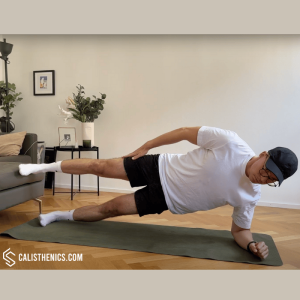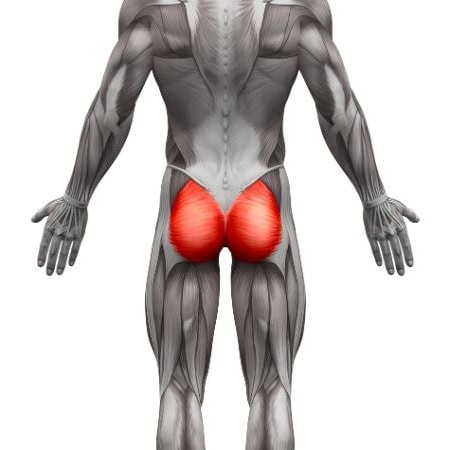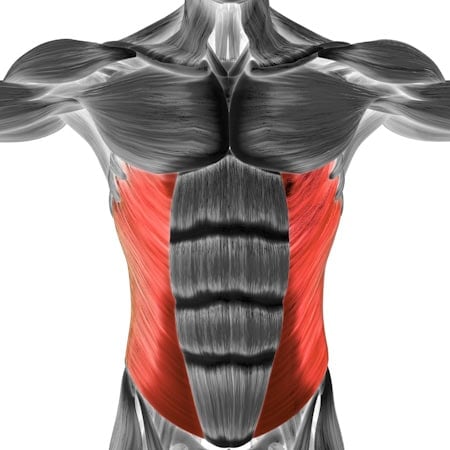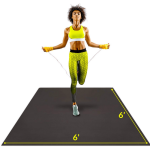Single Leg Side Plank
How to do Single Leg Side Plank?
Description & Steps to Perform the Exercise
The single-leg side plank is an advanced variation of the traditional side plank that adds extra challenge to the core, glutes, and stabilizing muscles by lifting one leg off the ground. This exercise strengthens the obliques, shoulders, glutes, and hips while improving overall core stability and balance. It’s an excellent way to build unilateral strength, work on muscle imbalances, and engage deeper stabilizers.
Steps to Perform a Proper Single-Leg Side Plank:
1. Set Up in the Side Plank Position:
• Begin by lying on your side with your legs stacked on top of each other and your forearm directly under your shoulder.
• Place your elbow on the floor directly below your shoulder to support your upper body, and keep your feet in line with your hips.
• Engage your core by pulling your belly button toward your spine, preparing your body for the lift.
2. Lift Into the Side Plank:
• Press through your forearm and the edge of your bottom foot to lift your hips off the floor, forming a straight line from your head to your feet. Your top arm can rest on your hip or be extended toward the ceiling for balance.
• Your body should be in a stable side plank position, with your core, glutes, and obliques engaged to maintain alignment.
3. Raise the Top Leg:
• Once stable in the side plank, lift your top leg up to about hip height, keeping it straight. This engages your glutes and increases the intensity of the plank.
• Focus on keeping your hips level and preventing them from sagging or rotating as you raise your leg. The lifted leg should remain in line with your body.
4. Hold the Position:
• Hold the single-leg side plank for the desired amount of time (e.g., 15-30 seconds per side), maintaining a strong and stable position.
• Keep your core tight, your glutes engaged, and your hips lifted throughout the hold.
5. Lower and Switch Sides:
• After completing the hold on one side, slowly lower your hips and leg back to the starting position and switch to the other side, repeating the same steps.
Benefits of Single-Leg Side Plank
• Strengthens the Core and Obliques: The single-leg side plank primarily targets the oblique muscles and core stabilizers, helping to improve core strength and stability.
• Enhances Glute Strength: Lifting the top leg during the side plank engages the gluteus medius and maximus, strengthening the muscles that support hip stability and mobility.
• Improves Balance and Coordination: This exercise challenges your ability to balance on one arm and one leg, improving overall body coordination and proprioception.
• Builds Shoulder Stability: The arm supporting the plank position works to stabilize the shoulder joint, enhancing shoulder strength and reducing the risk of injury.
• Corrects Muscle Imbalances: By focusing on one side of the body at a time, the single-leg side plank helps correct muscle imbalances, particularly in the hips and core.
• Improves Functional Strength: The single-leg side plank mimics real-life movements that require balance, coordination, and core strength, making it a highly functional exercise for athletes and individuals looking to improve overall fitness.
• Accessible Without Equipment: This exercise requires no equipment, making it easy to perform at home, at the gym, or while traveling.
Common Mistakes to Avoid
• Letting the Hips Sag: Avoid letting your hips drop during the exercise. Keep them lifted and in line with your body to ensure proper form and engagement of the core and glutes.
• Rotating the Hips: Keep your hips stacked directly on top of each other. Avoid twisting or rotating your hips, as this reduces core engagement and compromises form.
• Holding Your Breath: Don’t forget to breathe! Proper breathing helps maintain stability and focus during the hold.
• Lifting the Leg Too High: Avoid lifting your top leg too high, as this can cause instability and reduce the effectiveness of the exercise. Keep the leg in line with your body.
• Rushing Through the Movement: Take your time lifting and holding the leg. Moving too quickly can lead to a loss of balance and improper form.
Tips for the proper execution of Single Leg Side Plank
Engage the Core and Glutes: Focus on keeping your core tight and your glutes engaged to prevent your hips from sagging. This will help you maintain stability and proper alignment.
Keep Hips and Shoulders Aligned: Your body should form a straight line from head to foot, with your hips and shoulders stacked directly on top of each other.
Lift the Leg with Control: When lifting your top leg, move slowly and with control to avoid losing balance. The lift should be driven by your glutes, not momentum.
Breathe Steadily: Breathe continuously throughout the exercise. Exhale as you lift your leg, and inhale as you hold the position. Proper breathing helps maintain core engagement and focus.
Muscles worked when doing Single Leg Side Plank
Primary Muscles:
•Obliques: The side plank position primarily targets the oblique muscles, which stabilize the torso and resist lateral flexion.
•Glutes: The gluteus medius and maximus are engaged to lift and stabilize the hips, especially during the leg lift.
Secondary Muscles:
•Shoulders: The deltoids work to stabilize the upper body and support the arm that is holding the plank position.
•Core: The entire core, including the transverse abdominis and rectus abdominis, is engaged to stabilize the spine and maintain balance.
•Lower Back: The erector spinae muscles help maintain proper spinal alignment during the plank.
•Hip Flexors: Engage to help stabilize and lift the leg while maintaining the plank position.
•Quadriceps: Assist in keeping the legs straight and stable during the hold.
Primary Muscle(s):
Secondary Muscle(s):
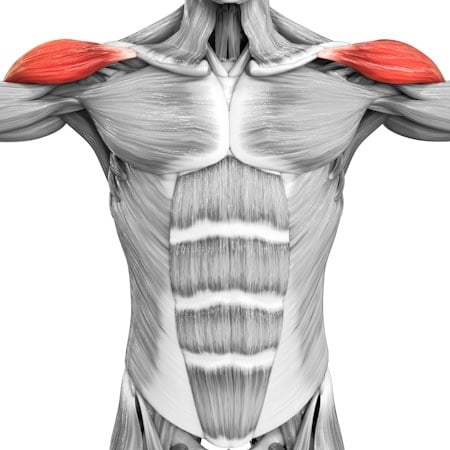
Lateral delt
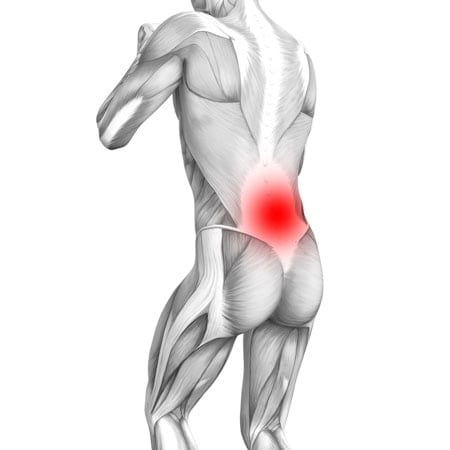
Lower back
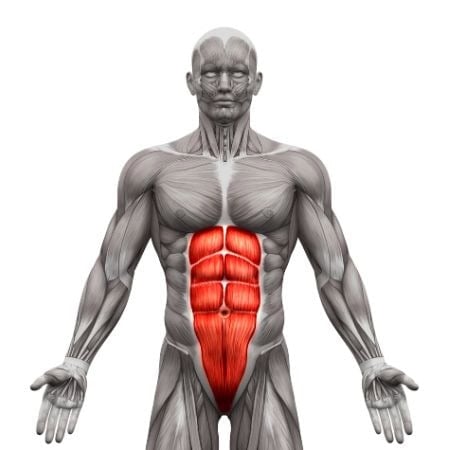
Abdominal
Adjust the difficulty of Single Leg Side Plank
How to make Single Leg Side Plank harder?
How to make Single Leg Side Plank easier?
How to make Single Leg Side Plank harder?
To make Single Leg Side Plank harder:
-
Increase Hold Time: Hold the single-leg side plank for longer periods (e.g., 45-60 seconds) to challenge your endurance and stability.
-
Add a Leg Pulsing Motion: Instead of holding the top leg still, perform small, controlled pulses up and down with the top leg to further engage the glutes and core.
-
Add Resistance: Hold a light dumbbell or weight plate in your top hand or wear ankle weights on your lifted leg to increase the difficulty and challenge your core and glutes more intensely.
-
Use an Unstable Surface: Perform the single-leg side plank on an unstable surface, such as a soft mat or balance disc, to further challenge your stability and core engagement.
How to make Single Leg Side Plank easier?
To make Single Leg Side Plank easier:
-
Perform a Standard Side Plank: Start with a traditional side plank (with both feet on the ground) to build core and shoulder stability before progressing to the single-leg variation.
-
Lower the Top Leg Slightly: Instead of lifting the top leg to hip height, raise it only slightly off the bottom leg. This reduces the intensity while still challenging your stability.
-
Hold for a Shorter Duration: Start with a shorter hold time (e.g., 10-15 seconds) and gradually increase as your strength improves.

